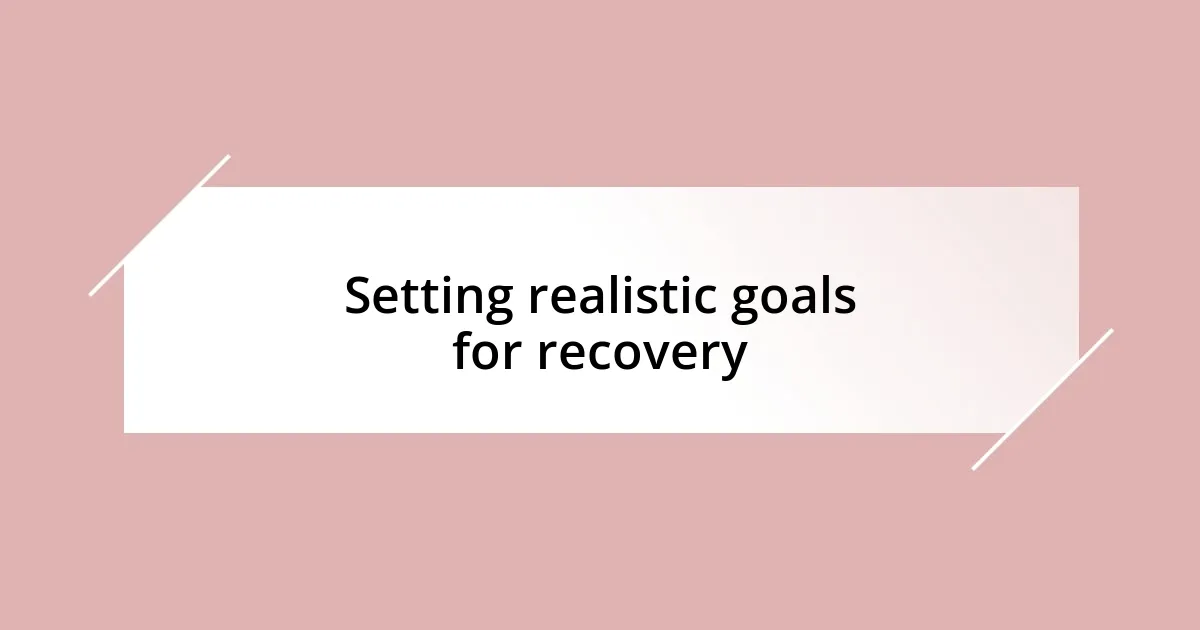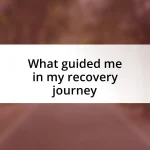Key takeaways:
- Resilience is a continuous process of growth that involves acknowledging pain and transforming it into strength.
- Recognizing signs of trauma, such as anxiety and emotional numbness, is crucial for seeking help and initiating healing.
- Building a supportive network, including friends, support groups, and therapists, fosters connection and encourages vulnerability.
- Setting realistic recovery goals helps to celebrate small achievements, reinforcing self-worth and resilience over time.

Understanding trauma and resilience
Trauma can feel like a dark cloud hanging over us, casting a shadow on every aspect of life. I remember feeling as if I was trapped in a loop of anxiety, constantly waiting for the next wave of despair to hit. It’s puzzling, isn’t it? How something that happens in an instant can linger and echo throughout our lives.
Resilience, on the other hand, is like a muscle that we can develop over time. After my own experience, I realized that resilience isn’t about denying pain; it’s about acknowledging it and finding ways to rise above it. Have you ever felt that moment when, against all odds, you decide to keep going? For me, it was a pivotal moment that sparked my journey toward healing.
Understanding the intricate relationship between trauma and resilience is essential. I learned that resilience is not a one-time achievement but rather a continuous process of growth. What if we embraced our vulnerabilities instead of hiding from them? That’s when true strength emerges, transforming our scars into badges of honor.

Recognizing the signs of trauma
Recognizing trauma is often more challenging than it seems. Initially, I didn’t even realize what I was feeling—a mix of agitation and numbness that had become my new normal. It’s vital to pay attention to these subtle changes in our emotional landscape. Often, the signs of trauma manifest in unexpected ways, impacting our daily interactions and personal well-being.
Here are some common signs to look out for:
- Increased Anxiety: I’d often feel on edge, like a coiled spring, anticipating the worst in situations that never warranted that level of fear.
- Emotional Numbness: There were moments when even joyful experiences felt muted; it was as if my heart had hit a wall.
- Withdrawal from Social Interactions: I found myself avoiding gatherings, craving isolation instead of connection.
- Intrusive Memories: Unexpected flashbacks caught me off guard, making it hard to focus on the present.
- Mood Swings: I experienced a rollercoaster of emotions that would swing from anger to sadness, often without an apparent trigger.
These signs are not just academic descriptions; they paint a picture of internal struggles I faced that might resonate with many. Recognizing these symptoms can be the first step toward seeking help and beginning the process of healing.

Developing emotional awareness and regulation
Developing emotional awareness is an essential step in navigating the aftermath of trauma. I often found myself reflecting on my reactions to various situations. Some days, I would feel a surge of anger over trivial matters, and other times, I’d be unexpectedly tearful. It was only when I started to pause and identify those emotions that I could begin to understand their roots. Have you ever stopped to ask yourself why you’re feeling a certain way? This practice opened new doors to self-compassion for me.
Regulating our emotions is another critical aspect of this journey. I learned that it wasn’t about suppressing what I felt but finding healthy ways to cope. For example, when overwhelming sadness washed over me, I’d engage in activities that brought me joy, like painting or taking a walk in nature. This approach helped me re-direct my emotional state into something constructive, transforming my feelings into a creative outlet. If you’ve ever had a moment where you regained control over a chaotic emotion, you know how empowering that can feel.
| Emotional Awareness | Emotional Regulation |
|---|---|
| Identifying feelings | Finding coping strategies |
| Reflecting on triggers | Using creative outlets |
| Practicing self-compassion | Re-directing emotions positively |

Building a supportive network
Building a supportive network was a game changer for me in my resilience journey. I realized early on that isolating myself only deepened my pain. So, I made a conscious effort to reach out to friends and family—people who had always been my safety net. Do you remember how something as simple as a supportive text can brighten a tough day? For me, just sharing a laugh or venting about my struggles reminded me that I wasn’t alone.
Finding people who understood my experience was transformative. I joined online support groups where members openly shared their stories. Hearing others talk about their struggles and victories made me feel less isolated. Have you ever connected with someone over shared experiences? That sense of camaraderie was incredibly uplifting; it was like a warm blanket of understanding wrapped around me.
In addition to friends and support groups, I leaned on a therapist who challenged me to be vulnerable. Talking through my feelings in a safe environment encouraged me to explore emotions I once buried deep. It wasn’t always easy, but with her help, I found that vulnerability is a strength, not a weakness. I remember one session where I finally let down my guard and cried. The relief that washed over me felt like a weight lifted, solidifying the importance of having a strong, understanding network around me.

Practicing self-care and mindfulness
Practicing self-care and mindfulness became vital to my healing process. I discovered that setting aside time for myself wasn’t selfish; it was necessary. I recall a period when I felt completely overwhelmed—simply sitting in silence for ten minutes each day transformed my perspective. Have you ever tried to quiet your mind during a storm of thoughts? That practice of stillness opened up space for reflection, allowing me to reconnect with myself and understand my needs better.
Incorporating mindfulness into daily activities has been equally impactful. I started to view simple tasks—like washing the dishes or taking a shower—as opportunities for mindfulness. By focusing on the sensations—the warm water, the texture of the soap—I found myself anchored in the present moment. It was surprising how such ordinary experiences became sources of peace. Have you ever noticed how being truly present can soften anxiety? Those small moments of mindfulness gradually built a reservoir of calm, helping me cope with life’s challenges.
Self-care activities like journaling and engaging in creative expression also played a pivotal role in my journey. One evening, while pouring my feelings onto the page, I realized how much clarity emerged from that vulnerable act. I often reflected on my entry, “What do I need right now to feel whole?” This simple question guided my self-care choices, whether it was taking a long bath or enjoying my favorite book. Have you ever asked yourself what you truly need in the moment? I found that honoring those needs not only fostered resilience but also nurtured a deeper connection to my inner self.

Setting realistic goals for recovery
Setting realistic goals for recovery became a crucial step in my journey towards resilience. I remember sitting down one day, overwhelmed by the enormity of my trauma, and realizing that aiming for perfection was setting myself up for failure. A small victory like getting out of bed on difficult days felt monumental. Have you ever found joy in simple achievements when everything feels heavy? That tiny win motivated me to set further achievable goals.
In the early days, I turned my ambitions into bite-sized, actionable steps. Instead of planning to conquer my fears all at once, I focused on one step at a time. For instance, I set a goal to take a short walk each day. I remember feeling proud the first time I ventured outside; the fresh air felt rejuvenating. Have you ever felt that rush of accomplishment from something seemingly simple? Those walks became a decisive part of my recovery, reminding me that progress doesn’t always mean leaping forward—it can simply be taking a step in the right direction.
Tracking my goals was another game changer. I started using a journal to document my progress, noting both the victories and the setbacks. Through this process, I learned to celebrate small successes while also acknowledging when things didn’t go as planned. I recall one week when I really struggled, but rereading my earlier entries made me realize how far I’d come. Why is it that we often overlook our own growth? Recognizing every achievement, no matter how minute, built my self-worth and, ultimately, my resilience.

Embracing growth and new beginnings
Embracing growth and new beginnings felt like uncovering a new part of myself that had been buried under the weight of trauma. I vividly remember the first day I decided to sign up for a pottery class. The idea was intimidating, yet the thought of creating something from raw materials ignited a sense of excitement in me. Have you ever stepped outside your comfort zone and found magic waiting on the other side? That class became a joyful outlet, allowing me to express my emotions through art, and with each piece, I felt a little more whole.
In many ways, embracing new beginnings meant redefining what success looked like for me. One morning, I looked out the window at a garden I had neglected for years and felt a pang of longing. I decided to get my hands dirty and start planting again. The simple act of nurturing growth—watching sprouts emerge from the soil—was therapeutic. Isn’t it remarkable how nature can teach us about resilience? Those delicate flowers became a powerful reminder that with patience and care, both in the garden and in life, beauty can emerge from even the most challenging circumstances.
Sometimes, the process of growth unfolded in surprising ways—like the day I connected with an old friend over coffee. I hadn’t realized how much I missed those deep conversations until we began to share our stories. As we talked about our respective journeys, it struck me how vulnerability creates connection. Have you ever felt a deep bond with someone just by opening up? That encounter reassured me that growth isn’t just a solitary endeavor; it often happens in the company of others who understand our struggles and triumphs, reminding us that we’re never truly alone in our journey.














